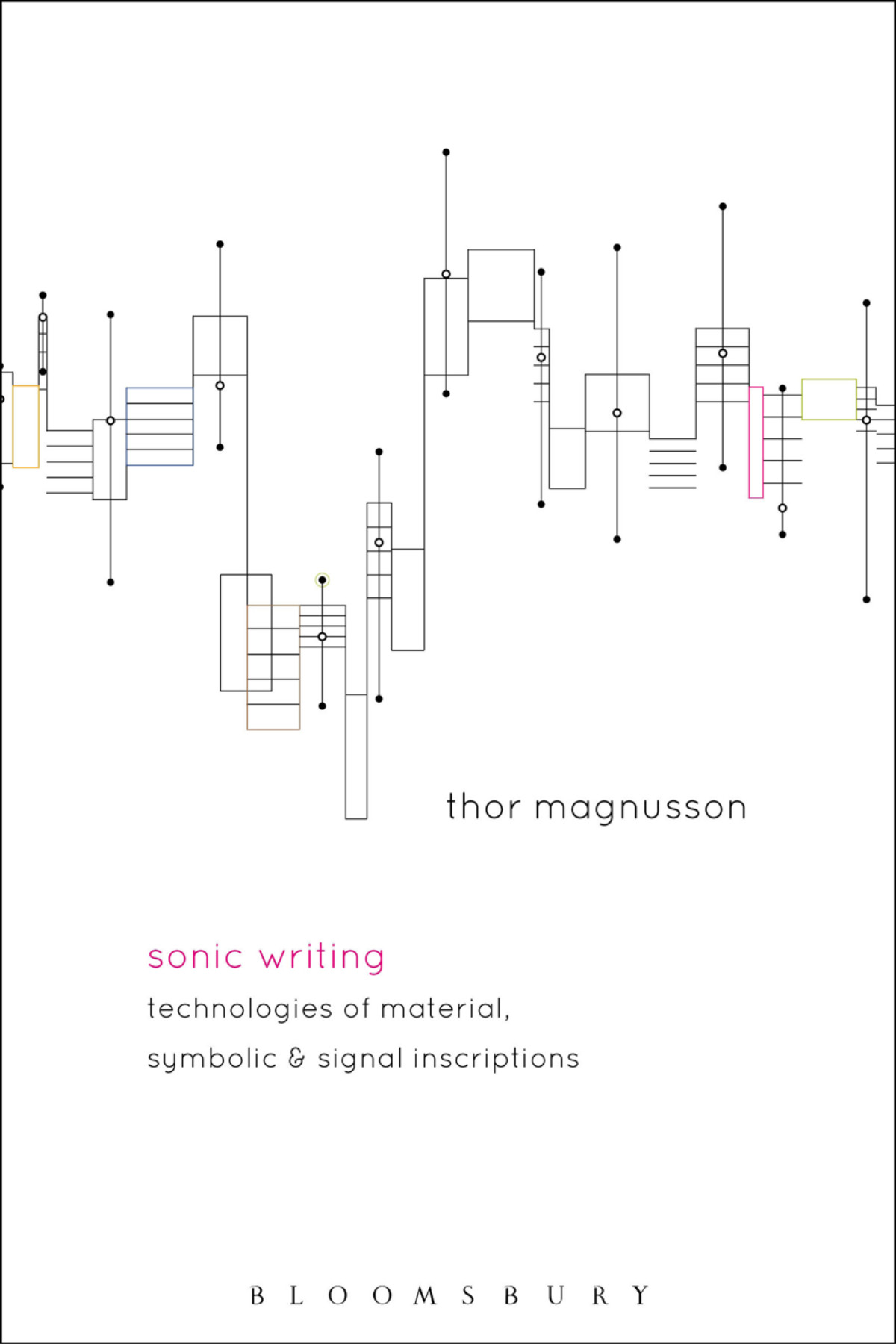Thor Magnusson: Sonic Writing: Technologies of Material, Symbolic, and Signal Inscriptions (2019)
Filed under book | Tags: · artificial intelligence, computer music, machine learning, media, media technology, media theory, music, musical instruments, notation, phonograph, sound, sound recording, writing

“Sonic Writing explores how contemporary music technologies trace their ancestry to previous forms of instruments and media. Studying the domains of instrument design, musical notation, and sound recording under the rubrics of material, symbolic, and signal inscriptions of sound, the book describes how these historical techniques of sonic writing are implemented in new digital music technologies. With a scope ranging from ancient Greek music theory, medieval notation, early modern scientific instrumentation to contemporary multimedia and artificial intelligence, it provides a theoretical grounding for further study and development of technologies of musical expression. The book draws a bespoke affinity and similarity between current musical practices and those from before the advent of notation and recording, stressing the importance of instrument design in the study of new music and projecting how new computational technologies, including machine learning, will transform our musical practices.
Sonic Writing offers a richly illustrated study of contemporary musical media, where interactivity, artificial intelligence, and networked devices disclose new possibilities for musical expression. Thor Magnusson provides a conceptual framework for the creation and analysis of this new musical work, arguing that contemporary sonic writing becomes a new form of material and symbolic design–one that is bound to be ephemeral, a system of fluid objects where technologies are continually redesigned in a fast cycle of innovation.”
Publisher Bloomsbury Academic, New York & London, 2019
ISBN 9781501313851, 1501313851
xiv+290 pages
Reviews: Gregory Taylor (Cycling ’74, 2019), Diana Chester (Interference, 2019).
Author’s research blog
Publisher
WorldCat
Neda Atanasoski, Kalindi Vora: Surrogate Humanity: Race, Robots, and the Politics of Technological Futures (2019)
Filed under book | Tags: · artificial intelligence, automation, capitalism, colonialism, ethics, feminism, labour, liberalism, machine, military, race, robotics, robots, technology, women, work

“In Surrogate Humanity Neda Atanasoski and Kalindi Vora trace the ways in which robots, artificial intelligence, and other technologies serve as surrogates for human workers within a labor system entrenched in racial capitalism and patriarchy. Analyzing myriad technologies, from sex robots and military drones to sharing-economy platforms, Atanasoski and Vora show how liberal structures of antiblackness, settler colonialism, and patriarchy are fundamental to human—machine interactions, as well as the very definition of the human. While these new technologies and engineering projects promise a revolutionary new future, they replicate and reinforce racialized and gendered ideas about devalued work, exploitation, dispossession, and capitalist accumulation. Yet, even as engineers design robots to be more perfect versions of the human—more rational killers, more efficient workers, and tireless companions—the potential exists to develop alternative modes of engineering and technological development in ways that refuse the racial and colonial logics that maintain social hierarchies and inequality.”
Publisher Duke University Press, Durham, NC, March 2019
Perverse Modernities series
ISBN 9781478003861, 1478003863
x+240 pages
Interview with authors: Lesia Pagulich, Tatsiana Shchurko (Feminist Critique, 2019).
Reviews:Sibille Merz (Ethnic & Racial Studies, 2019), Barbara Herr Harthorn (American Ethnologist, 2020), Anita Lam (Surveillance & Society, 2020), Andrea Flores (Information & Culture, 2020), Raquel Bosó Pérez (Sociology of Health & Illness, 2020), Nina Trige Andersen (Modern Times, c.2020), Kevin Pabst (Security Journal, 2020).
Comment (0)Algolit: Data Workers (2019) [English/French]
Filed under book, catalogue, wiki book | Tags: · algorithm, artificial intelligence, data, literature, machine learning, natural language processing, poetry, text

“Companies create artificial intelligence (AI) systems to serve, entertain, record and learn about humans. The work of these machinic entities is usually hidden behind interfaces and patents. In the exhibition, algorithmic storytellers left their invisible underworld to become interlocutors.
The data workers operate in different collectives. Each collective represents a stage in the design process of a machine learning model: there are the Writers, the Cleaners, the Informants, the Readers, the Learners and the Oracles. The boundaries between these collectives are not fixed; they are porous and permeable. At times, Oracles are also Writers. At other times Readers are also Oracles. Robots voice experimental literature, while algorithmic models read data, turn words into numbers, make calculations that define patterns and are able to endlessly process new texts ever after.
The exhibition foregrounded data workers who impact our daily lives, but are either hard to grasp and imagine or removed from the imagination altogether. It connected stories about algorithms in mainstream media to the storytelling that is found in technical manuals and academic papers. Robots were invited to engage in dialogue with human visitors and vice versa. In this way we might understand our respective reasonings, demystify each other’s behaviour, encounter multiple personalities, and value our collective labour.
It was also a tribute to the many machines that Paul Otlet and Henri La Fontaine imagined for their Mundaneum, showing their potential but also their limits.”
Texts: Cristina Cochior, Sarah Garcin, Gijs de Heij, An Mertens, François Zajéga, Louise Dekeuleneer, Florian Van de Weyer, Laetitia Trozzi, Rémi Forte, Guillaume Slizewicz.
Publisher Constant, Brussels, 2019
Free Art License
52 pages
PDF, PDF, HTML (English)
PDF, PDF, HTML (French)
Git

